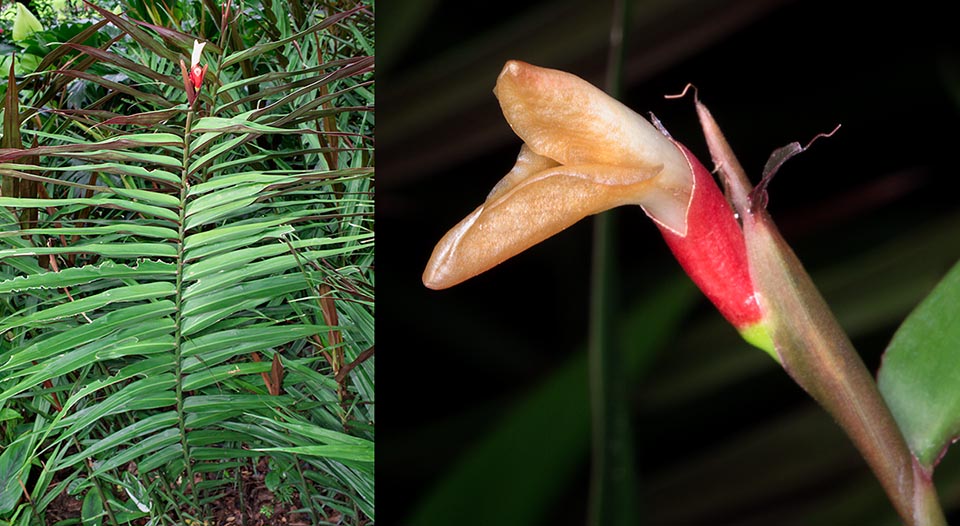Family : Zingiberaceae

Text © Pietro Puccio

English translation by Mario Beltramini
The species is native to Philippines (Luzon) where it grows in the humid forests on steep slopes around the 600 m of altitude.
The genus is honoured the the Italian physician and botanist Prospero Alpini (1553-1617); the specific name is the combination of the Latin adjective “luteus, a, um” = yellow and of the Greek substantive “καρπός” (carpós) = fruit, with obvious reference.
Common names: bamboo ginger, dwarf bamboo ginger, red bamboo ginger, small shell ginger (English).
The Alpinia luteocarpa Elmer (1939) is a perennial rhizomatous herbaceous species, evergreen, forming dense tufts with erect pseudo-stems, thin, 0,6-1,6 m tall, provided of alternate sessile leaves, simple, distichous, linear-lanceolate with pointed apex, arranged almost horizontally, of olive green colour above, dark purple red below. Panicle terminal inflorescence, about 30 cm tall, with groups of 3-5 fragrant flowers, subtended by various brown bracts, opening gradually. Tubular calyx of bright red colour, corolla from white to yellowish white with lobes merged at the base for a half of the length, labellum, formed by five sterile stamina fused together, of the same colour as the corolla, and one fertile stamen.

Native to Philippines, Alpinia luteocarpa reaches the 160 cm with elegant erect pseudostems with alternate sessile leaves, almost horizontal, dark purple below © G. Mazza
The fruits are subglobose to ellipsoid trilocular capsules, about 3 cm long and of 2 cm of diameter, yellow, containing several blackish seeds, up to 0,5 cm long. It reproduces by seed, previously kept in water for two days, in draining organic loam at the temperature of 22-24 °C, but usually and easily recourse is done to the division of the rhizomes. Species of contained dimensions with particularly ornamental foliage due to its unusual colour, to utilize in mass and for impressive borders in parks and gardens, even if little extended, of the tropical and humid subtropical climate zones, it is possible to try its cultivation in the milder temperate-warm zones where temperatures around the 0 °C are short lasting exceptions. It prefers a slightly shady position and soils rich of organic substance, draining, maintained constantly humid, but without stagnations. Thanks to its contained posture is an excellent plant to grow in pot for the decoration of patios, winter gardens and luminous indoors, utilizing a loam rich of humus with addition of coarse siliceous sand or agri perlite per a 30% for an excellent drainage. The fertilization can be done on a monthly basis, from spring to autumn, with a hydrosoluble balanced product, with microelements, specific for plants in pot.
